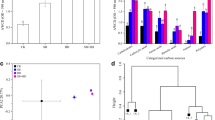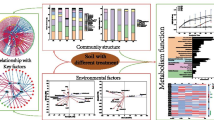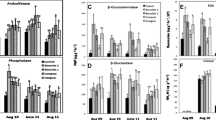Abstract
Reductive soil disinfestation (RSD) incorporated with sole plant residues or liquid-readily decomposable compounds is an effective management strategy to improve soil health. However, the synthetic effects of RSD incorporated with liquid-readily decomposable compounds and solid plant residues on soil ecosystem services remain unclear. Field experiments were carried out to investigate the effects of untreated soil (CK), RSD incorporated with sawdust (SA), molasses (MO), and their combinations (SA + MO) on the bacterial community and functional composition. The results showed that RSD treatments significantly altered soil bacterial community structure compared to CK treatment. The bacterial community structure and composition in MO and SA + MO treatments were clustered compared to SA treatment. This was mainly attributed to the readily decomposable carbon sources in molasses having a stronger driving force to reshape the soil microbial community during the RSD process. Furthermore, the functional compositions, such as the disinfestation efficiency of F. oxysporum (96.4 − 99.1%), abundances of nitrogen functional genes, soil metabolic activity, and functional diversity, were significantly increased in all of the RSD treatments. The highest disinfestation efficiency and abundances of denitrification (nirS and nrfA) and nitrogen fixation (nifH) genes were observed in SA + MO treatment. Specifically, SA + MO treatment enriched more abundant beneficial genera, e.g., Oxobacter, Paenibacillus, Cohnella, Rummeliibacillus, and Streptomyces, which were significantly and positively linked to disinfestation efficiency, soil metabolic activity, and denitrification processes. Our results indicated that combining RSD practices with liquid-readily decomposable compounds and solid plant residues could effectively improve soil microbial community and functional composition.





Similar content being viewed by others
Data Availability
The raw sequencing data were deposited at the NCBI Sequence Read Archive database with the accession number of PRJNA858391.
References
Janvier C, Villeneuve F, Alabouvette C, Edel-Hermann V, Mateille T, Steinberg C (2007) Soil health through soil disease suppression: which strategy from descriptors to indicators? Soil Biol Biochem 39:1–23. https://doi.org/10.1016/j.soilbio.2006.07.001
Shen WS, Lin XG, Gao N, Zhang HY, Yin R, Shi WM, Duan ZQ (2008) Land use intensification affects soil microbial populations, functional diversity and related suppressiveness of cucumber Fusarium wilt in China’s Yangtze River Delta. Plant Soil 306:117–127. https://doi.org/10.1007/s11104-007-9472-5
Shen WS, Hu MC, Qian D, Xue HW, Gao N, Lin XG (2021) Microbial deterioration and restoration in greenhouse-based intensive vegetable production systems. Plant Soil 463:1–18. https://doi.org/10.1007/s11104-021-04933-w
Liu LL, Kong JJ, Cui HL, Zhang JB, Wang FH, Cai ZC, Huang XQ (2016) Relationships of decomposability and C/N ratio in different types of organic matter with suppression of Fusarium oxysporum and microbial communities during reductive soil disinfestation. Biol Control 101:103–113. https://doi.org/10.1016/j.biocontrol.2016.06.011
Momma N, Yamamoto K, Simandi P, Shishido M (2006) Role of organic acids in the mechanisms of biological soil disinfestation (BSD). J Gen Plant Pathol 72:247–252. https://doi.org/10.1007/s10327-006-0274-z
Mowlick S, Inoue T, Takehara T, Kaku N, Ueki K, Ueki A (2013) Changes and recovery of soil bacterial communities influenced by biological soil disinfestation as compared with chloropicrin-treatment. AMB Express 3:46–58. https://doi.org/10.1186/2191-0855-3-46
Poret-Peterson AT, Albu S, Mcclean AE, Kluepfel DA (2019) Shifts in soil bacterial communities as a function of carbon source used during anaerobic soil disinfestation. Front Environ Sci 6:160. https://doi.org/10.3389/fenvs.2018.00160
Huang XQ, Liu LL, Zhao J, Zhang JB, Cai ZC (2019) The families Ruminococcaceae, Lachnospiraceae, and Clostridiaceae are the dominant bacterial groups during reductive soil disinfestation with incorporated plant residues. Appl Soil Ecol 135:65–72. https://doi.org/10.1016/j.apsoil.2018.11.011
Hewavitharana SS, Klarer E, Reed AJ, Leisso R, Poirier B, Honaas L, Rudell DR, Mazzola M (2019) Temporal dynamics of the soil metabolome and microbiome during simulated anaerobic soil disinfestation. Front Microbiol 10:2365. https://doi.org/10.3389/fmicb.2019.02365
Ueki A, Kaku N, Ueki K (2018) Role of anaerobic bacteria in biological soil disinfestation for elimination of soil-borne plant pathogens in agriculture. Appl Microbiol Biotechnol 102:6309–6318. https://doi.org/10.1007/s00253-018-9119-x
Hewavitharana SS, Ruddell D, Mazzola M (2014) Carbon source-dependent antifungal and nematicidal volatiles derived during anaerobic soil disinfestation. Eur J Plant Pathol 140:39–52. https://doi.org/10.1007/s10658-014-0442-5
Mowlick S, Yasukawa H, Inoue T, Takehara T, Kaku N, Ueki K, Ueki A (2013) Suppression of spinach wilt disease by biological soil disinfestation incorporated with Brassica juncea plants in association with changes in soil bacterial communities. Crop Prot 54:185–193. https://doi.org/10.1016/j.cropro.2013.08.012
Momma N, Momma M, Kobara Y (2010) Biological soil disinfestation using ethanol: effect on Fusarium oxysporum f. sp lycopersici and soil microorganisms. J Gen Plant Pathol 76:336–344. https://doi.org/10.1007/s10327-010-0252-3
Muramoto J, Shennan C, Baird G, Zavatta M, Koike ST, Bolda MP, Daugovish O, Dara SK, Klonsky K, Mazzola M (2014) Optimizing anaerobic soil disinfestation for California strawberries. Acta Hortic 1044:215–220. https://doi.org/10.17660/ActaHortic.2014.1044.25.
Huang XQ, Zhao J, Zhou X, Han YS, Zhang JB, Cai ZC (2019) How green alternatives to chemical pesticides are environmentally friendly and more efficient. Eur J Soil Sci 70:518–529. https://doi.org/10.1111/ejss.12755
Liu LL, Chen SH, Zhao J, Zhou X, Wang BY, Li YL, Zheng GQ, Zhang JB, Cai ZC, Huang XQ (2018) Watermelon planting is capable to restructure the soil microbiome that regulated by reductive soil disinfestation. Appl Soil Ecol 129:52–60. https://doi.org/10.1016/j.apsoil.2018.05.004
Shrestha U, Ownley BH, Bruce A, Rosskopf EN, Butler DM (2021) Anaerobic soil disinfestation efficacy against Fusarium oxysporum is affected by soil temperature, amendment type, rate, and C: N ratio. Phytopathology 111:1380–1392. https://doi.org/10.1094/phyto-07-20-0276-r
Shrestha U, Auge RM, Butler DM (2016) A meta-analysis of the impact of anaerobic soil disinfestation on pest suppression and yield of horticultural crops. Front Plant Sci 7:1254. https://doi.org/10.3389/fpls.2016.01254
Hu JL, Lin XG, Wang JH, Dai J, Chen RR, Zhang JB, Wong MH (2011) Microbial functional diversity, metabolic quotient, and invertase activity of a sandy loam soil as affected by long-term application of organic amendment and mineral fertilizer. J Soils Sediments 11:271–280. https://doi.org/10.1007/s11368-010-0308-1
Kelly JJ, Peterson E, Winkelman J, Walter TJ, Rier ST, Tuchman NC (2013) Elevated atmospheric CO2 impacts abundance and diversity of nitrogen cycling functional genes in soil. Microb Ecol 65:394–404. https://doi.org/10.1007/s00248-012-0122-y
Chaudhry V, Rehman A, Mishra A, Chauhan PS, Nautiyal CS (2012) Changes in bacterial community structure of agricultural land due to long-term organic and chemical amendments. Microb Ecol 64:450–460. https://doi.org/10.1007/s00248-012-0025-y
Govaerts B, Mezzalama M, Unno Y, Sayre KD, Luna-Guido M, Vanherck K, Dendooven L, Deckers J (2007) Influence of tillage, residue management, and crop rotation on soil microbial biomass and catabolic diversity. Appl Soil Ecol 37:18–30. https://doi.org/10.1016/j.apsoil.2007.03.006
Huang XQ, Zhao J, Zhou X, Zhang JB, Cai ZC (2019) Differential responses of soil bacterial community and functional diversity to reductive soil disinfestation and chemical soil disinfestation. Geoderma 348:124–134. https://doi.org/10.1016/j.geoderma.2019.04.027
Zhao J, Liu SZ, Zhou X, Xia Q, Liu X, Zhang SR, Zhang JB, Cai ZC, Huang XQ (2020) Reductive soil disinfestation incorporated with organic residue combination significantly improves soil microbial activity and functional diversity than sole residue incorporation. Appl Microbiol Biotechnol 104:7573–7588. https://doi.org/10.1007/s00253-020-10778-7
Huang J, Cao C, Liu JL, Yan CN, Xiao J (2019) The response of nitrogen removal and related bacteria within constructed wetlands after long-term treating wastewater containing environmental concentrations of silver nanoparticles. Sci Total Environ 667:522–531. https://doi.org/10.1016/j.scitotenv.2019.02.396
Xu HJ, Wang XH, Li H, Yao HY, Su JQ, Zhu YG (2014) Biochar impacts soil microbial community composition and nitrogen cycling in an acidic soil planted with rape. Environ Sci Technol 48:9391–9399. https://doi.org/10.1021/es5021058
Huang XQ, Liu LL, Wen T, Zhang JB, Wang FH, Cai ZC (2016) Changes in the soil microbial community after reductive soil disinfestation and cucumber seedling cultivation. Appl Microbiol Biotechnol 100:5581–5593. https://doi.org/10.1007/s00253-016-7362-6
IUSS Working Group WRB (2007) World Reference Base for Soil Resources 2006, first update 2007. World Soil Resources Reports No. 103. FAO, Rome
Muramoto J, Shennan C, Mazzola M, Wood T, Miethke E, Resultay E, Zavatta M, Koike ST (2020) Use of a summer cover crop as a partial carbon source for anaerobic soil disinfestation in coastal California. ActaHortic 1270:37–44. https://doi.org/10.17660/ActaHortic.2020.1270.4.
Bremner JGM, Jenkinson DS (1960) Determination of organic carbon in soil. I. Oxidation by dichromate of organic matter in soil and plant materials. Eur J Soil Sci 11:394–402. https://doi.org/10.1111/j.1365-2389.1960.tb01093.x
Liu LL, Huang XQ, Zhang JB, Cai ZC, Jiang K, Chang YY (2020) Deciphering the relative importance of soil and plant traits on the development of rhizosphere microbial communities. Soil Biol Biochem 148:107909. https://doi.org/10.1016/j.soilbio.2020.107909
Zhao J, Ni T, Li J, Lu Q, Fang ZY, Huang QW, Zhang RF, Li R, Shen B, Shen QR (2016) Effects of organic-inorganic compound fertilizer with reduced chemical fertilizer application on crop yields, soil biological activity and bacterial community structure in a rice-wheat cropping system. Appl Soil Ecol 99:1–12. https://doi.org/10.1016/j.apsoil.2015.11.006
Garland JL, Mills AL (1991) Classification and characterization of heterotrophic microbial communities on the basis of patterns of community-level sole-carbon-source utilization. Appl Environ Microbiol 57:2351–2359. https://doi.org/10.1128/aem.57.8.2351-2359.1991
Ping CL, Jastrow JD, Jorgenson MT, Michaelson GJ, Shur YL (2015) Permafrost soils and carbon cycling. Soil 1:147–171. https://doi.org/10.5194/soil-1-147-2015
Wang R, Wang M, Wang J, Yao JH, Li XW, Lin YH, Du FK (2021) Soil bacterial characteristics under four habitats with different vegetation communities on the Qinghai-Tibetan plateau. Wetlands 41:58. https://doi.org/10.1007/s13157-021-01455-0
Bu LY, Peng ZH, Tian J, Song FQ, Wei GH, Wang HL (2020) Distinct abundance patterns of nitrogen functional microbes in desert soil profiles regulate soil nitrogen storage potential along a desertification development gradient. CATENA 194:104716. https://doi.org/10.1016/j.catena.2020.104716
Bolyen E, Rideout JR, Dillon MR, Bokulich N, Abnet CC et al (2019) Reproducible, interactive, scalable and extensible microbiome data science using QIIME 2. Nat Biotechnol 37:852–857. https://doi.org/10.1038/s41587-019-0209-9
Callahan BJ, Mcmurdie PJ, Rosen MJ, Han AW, Johnson AJA, Holmes SP (2016) DADA2: High-resolution sample inference from Illumina amplicon data. Nat Methods 13:581–583. https://doi.org/10.1038/nmeth.3869
Garland JL (1996) Analytical approaches to the characterization of samples of microbial communities using patterns of potential C source utilization. Soil Biol Biochem 28:213–221. https://doi.org/10.1016/0038-0717(95)00112-3
Feigl V, Ujaczki E, Vaszita E, Molnar M (2017) Influence of red mud on soil microbial communities: Application and comprehensive evaluation of the Biolog EcoPlate approach as a tool in soil microbiological studies. Sci Total Environ 595:903–911. https://doi.org/10.1016/j.scitotenv.2017.03.266
Mcmurdie PJ, Holmes S (2013) phyloseq: an R package for reproducible interactive analysis and graphics of microbiome census data. PLoS ONE 8:e61217. https://doi.org/10.1371/journal.pone.0061217
Fisk MC, Ruether KF, Yavitt JB (2003) Microbial activity and functional composition among northern peatland ecosystems. Soil Biol Biochem 35:591–602. https://doi.org/10.1016/s0038-0717(03)00053-1
Segata N, Izard J, Waldron L, Gevers D, Miropolsky L, Garrett WS, Huttenhower C (2011) Metagenomic biomarker discovery and explanation. Genome Biol 12:R60. https://doi.org/10.1186/gb-2011-12-6-r60
Anderson TH (2003) Microbial eco-physiological indicators to asses soil quality. Agric Ecosyst Environ 98:285–293. https://doi.org/10.1016/s0167-8809(03)00088-4
Shi WM, Yao J, Yan F (2009) Vegetable cultivation under greenhouse conditions leads to rapid accumulation of nutrients, acidification and salinity of soils and groundwater contamination in South-Eastern China. Nutr Cycl Agroecosyst 83:73–84. https://doi.org/10.1007/s10705-008-9201-3
Lin YX, Hu HW, Ye GP, Fan JB, Ding WX, He ZY, Zheng Y, He JZ (2021) Ammonia-oxidizing bacteria play an important role in nitrification of acidic soils: a meta-analysis. Geoderma 404:115395. https://doi.org/10.1016/j.geoderma.2021.115395
Buckley DH, Huangyutitham V, Hsu SF, Nelson TA (2007) Stable isotope probing with N-15(2) reveals novel noncultivated diazotrophs in soil. Appl Environ Microbiol 73:3196–3204. https://doi.org/10.1128/aem.02610-06
Lammel DR, Feigl BJ, Cerri CC, Nusslein K (2015) Specific microbial gene abundances and soil parameters contribute to C, N, and greenhouse gas process rates after land use change in Southern Amazonian Soils. Front Microbiol 6:1057. https://doi.org/10.3389/fmicb.2015.01057
Wagg C, Bender SF, Widmer F, Van Der Heijden MGA (2014) Soil biodiversity and soil community composition determine ecosystem multifunctionality. PNAS 111:5266–5270. https://doi.org/10.1073/pnas.1320054111
Bonanomi G, Antignani V, Capodilupo M, Scala F (2010) Identifying the characteristics of organic soil amendments that suppress soilborne plant diseases. Soil Biol Biochem 42:136–144. https://doi.org/10.1016/j.soilbio.2009.10.012
Gilardi G, Pugliese M, Gulli-No ML, Garibaldi A (2020) Evaluation of different carbon sources for anaerobic soil disinfestation against Rhizoctonia solani on lettuce in controlled production systems. Phytopathol Mediterr 59:77–95. https://doi.org/10.14601/Phyto-10911
Li B, Li Q, Xu ZH, Zhang N, Shen QR, Zhang RF (2014) Responses of beneficial Bacillus amyloliquefaciens SQR9 to different soilborne fungal pathogens through the alteration of antifungal compounds production. Front Microbiol 5:636. https://doi.org/10.3389/fmicb.2014.00636
Verbaendert I, Boon N, De Vos P, Heylen K (2011) Denitrification is a common feature among members of the genus Bacillus. Syst Appl Microbiol 34:385–391. https://doi.org/10.1016/j.syapm.2011.02.003
Wei ZS, Wang JB, Huang ZS, Xiao XL, Tang MR, Li BL, Zhang X (2019) Removal of nitric oxide from biomass combustion by thermophilic nitrification-aerobic denitrification combined with catalysis in membrane biofilm reactor. Biomass Bioenergy 126:34–40. https://doi.org/10.1016/j.biombioe.2019.05.004
Bengelsdorf FR, Poehlein A, Schiel-Bengelsdorf B, Daniel R, Durre P (2015) Genome sequence of the acetogenic bacterium Oxobacter pfennigii DSM 3222T. Genome Announc 3:e1408–e1415. https://doi.org/10.1128/genomeA.01408-15
Chantorn S, Aekkawatchai N, Kasinsak K, Oontawee S (2022) Preservation of Paenibacillus polymyxa BTK01 and Bacillus subtilis BTK07 as lignocellulolytic bacterial starters for industrial applications: Physicochemical conditions, enzyme stability, freeze-drying processes and cryoprotection. Biocatal Agric Biotechnol 42:102326. https://doi.org/10.1016/j.bcab.2022.102326
Essarioui A, Leblanc N, Kistler HC, Kinkel LL (2017) Plant community richness mediates inhibitory interactions and resource competition between Streptomyces and Fusarium populations in the rhizosphere. Microb Ecol 74:157–167. https://doi.org/10.1007/s00248-016-0907-5
Kim DY, Han MK, Oh HW, Bae KS, Jeong TS, Kim SU, Shin DH, Kim IH, Rhee YH, Son KH, Park HY (2010) Novel intracellular GH10 xylanase from Cohnella laeviribosi HY-21: Biocatalytic properties and alterations of substrate specificities by site-directed mutagenesis of Trp residues. Bioresour Technol 101:8814–8821. https://doi.org/10.1016/j.biortech.2010.06.023
Acknowledgements
We thank Yonggen Yuan for providing the experimental field of this study. The authors also thank the editors and reviewers for their valuable comments and suggestions.
Funding
This work was financially supported by the National Natural Science Foundation of China (Grant No. 32160748 and 42090065), the Key Research and Development Project (Agriculture) of Yichun City, Jiangxi Province (20211YFN4240), and the China Postdoctoral Science Foundation (2021M691625).
Author information
Authors and Affiliations
Contributions
Zucong Cai, Xinqi Huang, and Liangliang Liu conceived designed research. Yuanyuan Yan, Yi Xie, Jingqing Zhang, and Ruimin Li performed the experiment and collected the data. Yuanyuan Yan, Liangliang Liu, and Ahmad Ali analyzed the data. Yuanyuan Yan and Yi Xie wrote and revised the manuscript. All authors read and approved the manuscript.
Corresponding author
Ethics declarations
Competing Interests
The authors declare no competing interests.
Supplementary Information
Below is the link to the electronic supplementary material.
Rights and permissions
Springer Nature or its licensor (e.g. a society or other partner) holds exclusive rights to this article under a publishing agreement with the author(s) or other rightsholder(s); author self-archiving of the accepted manuscript version of this article is solely governed by the terms of such publishing agreement and applicable law.
About this article
Cite this article
Yan, Y., Xie, Y., Zhang, J. et al. Effects of Reductive Soil Disinfestation Combined with Liquid-Readily Decomposable Compounds and Solid Plant Residues on the Bacterial Community and Functional Composition. Microb Ecol 86, 1132–1144 (2023). https://doi.org/10.1007/s00248-022-02139-w
Received:
Accepted:
Published:
Issue Date:
DOI: https://doi.org/10.1007/s00248-022-02139-w




